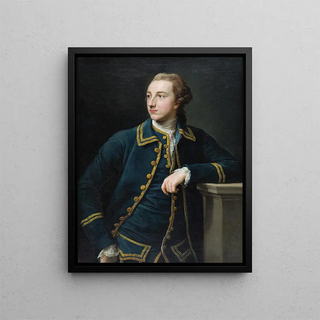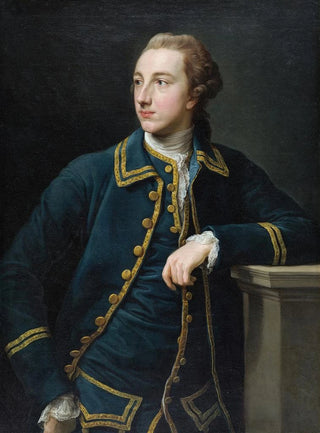Art print | Portrait of a man in a green suit - Pompeo Batoni Source: Reproduction | Portrait d'un homme en costume vert - Pompeo Batoni


View from behind

Frame (optional)
In the artistic landscape of the 18th century, the portrait holds a prominent place, reflecting the aspirations and identities of the elites of the time. Among these masterpieces, the "Portrait of a man in a green suit" by Pompeo Batoni stands out for its elegance and psychological depth. This artwork, which captures the very essence of its subject, invites the viewer to delve into a universe where refinement and introspection meet. The artist, through this representation, offers us a window into an era where fashion and personality intertwined in a delicate dance, revealing the nuances of the human soul.
Style and uniqueness of the work
Batoni's style is characterized by undeniable technical mastery, combined with a particular sensitivity to details. In the "Portrait of a man in a green suit," the brightness of the colors and the finesse of the features give the canvas an atmosphere that is both lively and timeless. The choice of the green suit, rich and vibrant, not only enhances the stature of the character but also suggests a certain nobility. Delicate shadows and skillfully placed lights create a contrast that brings the face to life, making the subject's expression both accessible and mysterious. This portrait does not merely depict an individual; it captures an essence, a story, and evokes emotions that transcend time.
The artist and his influence
Pompeo Batoni, an emblematic figure of Neoclassicism, established himself as one of the most sought-after portraitists of his era. His career, marked by diverse influences ranging from Baroque to Renaissance, allowed him to develop a unique style that combines tradition and innovation. Batoni had the opportunity to paint many personalities of European nobility, and his works often served as models for other artists. His approach to portraiture, which emphasizes the psychology of the subject and the importance of context, paved the way for a new way of conceiving human representation. Thus, his influence endures, inspiring generations of artists who see in him a master in the art of capturing the soul.
An exceptional wall decoration signed Artem Le

Matte finish

View from behind

Frame (optional)
In the artistic landscape of the 18th century, the portrait holds a prominent place, reflecting the aspirations and identities of the elites of the time. Among these masterpieces, the "Portrait of a man in a green suit" by Pompeo Batoni stands out for its elegance and psychological depth. This artwork, which captures the very essence of its subject, invites the viewer to delve into a universe where refinement and introspection meet. The artist, through this representation, offers us a window into an era where fashion and personality intertwined in a delicate dance, revealing the nuances of the human soul.
Style and uniqueness of the work
Batoni's style is characterized by undeniable technical mastery, combined with a particular sensitivity to details. In the "Portrait of a man in a green suit," the brightness of the colors and the finesse of the features give the canvas an atmosphere that is both lively and timeless. The choice of the green suit, rich and vibrant, not only enhances the stature of the character but also suggests a certain nobility. Delicate shadows and skillfully placed lights create a contrast that brings the face to life, making the subject's expression both accessible and mysterious. This portrait does not merely depict an individual; it captures an essence, a story, and evokes emotions that transcend time.
The artist and his influence
Pompeo Batoni, an emblematic figure of Neoclassicism, established himself as one of the most sought-after portraitists of his era. His career, marked by diverse influences ranging from Baroque to Renaissance, allowed him to develop a unique style that combines tradition and innovation. Batoni had the opportunity to paint many personalities of European nobility, and his works often served as models for other artists. His approach to portraiture, which emphasizes the psychology of the subject and the importance of context, paved the way for a new way of conceiving human representation. Thus, his influence endures, inspiring generations of artists who see in him a master in the art of capturing the soul.
An exceptional wall decoration signed Artem Le






